Method for obtaining 2,6-dimethylnaphthalene using isomerization and crystallization processes
a technology of dimethyl naphthalene and isomerization, which is applied in the direction of hydrocarbon purification/separation, chemical apparatus and processes, organic chemistry, etc., can solve the problems of high production cost, relatively low yield, and relatively high fixed investment cost, and achieve high yield
- Summary
- Abstract
- Description
- Claims
- Application Information
AI Technical Summary
Benefits of technology
Problems solved by technology
Method used
Image
Examples
example 1
[0088]Using the device as depicted in FIG. 1, the process was performed. In order to remove the low boiling point materials and the high boiling point materials, as by-products or unreacted materials, contained in the raw materials to be injected, that is, the raw materials rich in 1,5-DMN, which had been obtained from the dehydrogenation reaction, two processes using distillation columns were performed. The distillation column was made of stainless steel, and the inner side of the distillation column was filled with packings, such that the distillation column was designed and fabricated to comprise 15 theoretical stages. Separation of the distillation column was designed so as to allow separation according to the amount to be injected of 5 kg / hour. A raw material to be injected in an amount of 5 kg / hour was heated and distilled under the condition for operation of the distillation column for removing the first low boiling point materials such that the pressure and the temperature o...
example 2
[0089]In Example 2, the same procedure as in Example 1 except that the condition for operation of the distillation column is changed such that the pressure and the temperature of the top of the column for removing the first low boiling point materials are 130 mmHg and 180° C., respectively, and the temperature of the bottom of the column is 200° C.; and the temperature and the pressure of the top of the second DMN distillation column are 165° C. and 45 mmHg, and the temperature of the bottom of the column is 210° C., was performed. Results of analysis on the product of Example 2 are shown in Table 4.
example 3
[0090]In Example 3, the same procedure as in Example 1 except that the composition of the raw materials to be supplied is varied depending on the recycling process, was performed. Results of GC analysis on Example 3 were shown in Table 4.
[0091]As seen from the results of Examples 1 to 3, using the distillation column designed according to the present invention, low boiling point materials and high boiling point materials can be easily removed, and as a result, it is possible to obtain pure DMN isomers without low boiling point materials and high boiling point materials.
[0092]
TABLE 4Example 1Example 2Example 3CompositionCompositionCompositionCompositionCompositionofofofofofComposition ofL.P.H.P.L.P.H.P.L.P.H.P.materialsmaterialsmaterialsmaterialsmaterialsmaterialsafterafterafterafterafterafterpurificationpurificationpurificationpurificationpurificationpurificationRawononRawononRawononItemsmaterialscolumncolumnmaterialscolumncolumnmaterialscolumncolumnComposition2,6-DMN0.742.452.050.1...
PUM
| Property | Measurement | Unit |
|---|---|---|
| temperature | aaaaa | aaaaa |
| temperature | aaaaa | aaaaa |
| temperature | aaaaa | aaaaa |
Abstract
Description
Claims
Application Information
 Login to View More
Login to View More - R&D
- Intellectual Property
- Life Sciences
- Materials
- Tech Scout
- Unparalleled Data Quality
- Higher Quality Content
- 60% Fewer Hallucinations
Browse by: Latest US Patents, China's latest patents, Technical Efficacy Thesaurus, Application Domain, Technology Topic, Popular Technical Reports.
© 2025 PatSnap. All rights reserved.Legal|Privacy policy|Modern Slavery Act Transparency Statement|Sitemap|About US| Contact US: help@patsnap.com


